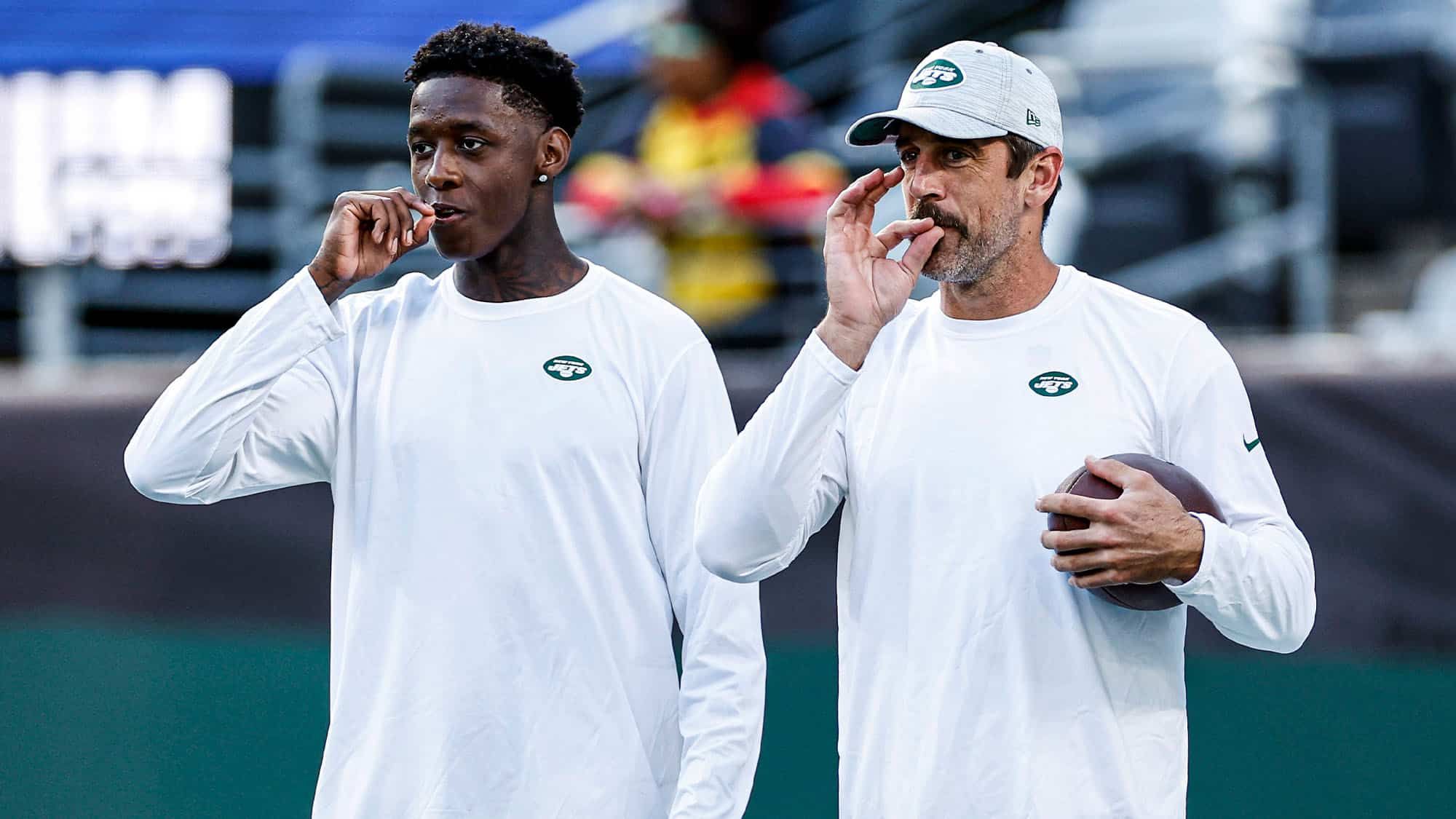Aaron Rodgers is the primary path to improvement for the New York Jets’ defense
The New York Jets’ defense has already established itself as one of the absolute best in the NFL. In 2023, they ranked third-best in defensive DVOA, trailing only the Cleveland Browns and Baltimore Ravens. Over the past two seasons combined, they are tied for second in the NFL with 17 games holding the opponent under 300 yards, trailing only the San Francisco 49ers.
The Jets are in the conversation for the best defensive team in the NFL. The next step? Eliminating the conversation entirely. They must strive to become the indisputable best defense in the NFL.
And believe it or not, the man who gives them the best chance to pull it off is Aaron Rodgers.
On paper, the Jets’ defensive roster looks similarly talented to last year’s. All of their Pro Bowl and/or All-Pro players will return. The Jets lost some key pieces, but they did a nice job of replacing them, and they have numerous young players who are due for leaps in performance.
What gives the Jets’ defense a chance to take another leap in 2024 is not a change in their collective talent level. Rather, it’s an improvement in the opportunities presented to them by the offense.
New York has achieved its defensive excellence despite being forced into unfavorable game scripts by an abominable offense. Look no further than the field position handed to them as a byproduct of turnovers and three-and-outs. In 2023, the Jets’ defense ranked 24th in average starting field position, and in 2022, they ranked 30th.
Better play from the offense, sparked by the upgrade from Zach Wilson to Rodgers, should allow the defense to play with better field position. They will face fewer short fields in which points are gift-wrapped to the opponent off of a turnover, which was a common occurrence last season; the Jets had the third-most defensive drives that started in their own territory with 26. They will also face more long fields in which the opponent is backed against their own end zone, forcing them into mistakes.
Another massive advantage of having Rodgers is that he will force a more favorable pass-run split from the opponent. With league-worst offensive production over the past two years, the Jets almost never held large leads, which meant the defense was rarely given opportunities to tee off on opponents in obvious passing situations. Opponents were able to ground-and-pound the rock for four quarters, neutralizing the Jets’ explosive pass rush.
In 2023, the Jets’ defense faced the third-most rush attempts per game (30.4) and the fourth-fewest pass attempts per game (30.7). Their opponent pass play percentage was 52.4%, third-lowest in the NFL. In fourth quarters, that rate dropped all the way to 41.6% (also third-lowest).
Fewer passes means fewer opportunities to create sacks and turnovers. If the opponent is allowed to run the ball to their heart’s content, it becomes easy to protect the football, control the clock, and avoid big losses of yardage.
This is especially true in end-of-game situations. When teams are desperately throwing the ball on every play at the end of the game, they are at their most reckless. But since the Jets’ offense couldn’t build big leads, opponents were able to run the ball nearly three-fifths of the time in fourth quarters. As a defense, it’s nearly impossible to make game-altering plays with such a ratio, no matter how talented you are.
In the rare situations where the Jets’ defense has been able to tee off on opponents in obvious passing situations, we’ve seen them seize control of games. The fourth quarters against Buffalo in 2022, Denver in 2023, and Philadelphia in 2023 are perfect examples. The Jets held late leads and knew the opponent was going to pass on every play to try and come back. Between Sauce Gardner’s game-winning pass breakup on Gabriel Davis, Quincy Williams’ strip-sack on Russell Wilson, and the Jets’ lockdown coverage on four consecutive plays against Jalen Hurts, they have proven they are borderline unbeatable if they know the opponent is going to throw the ball.
Sauce Gardner closes the door on the Bills on 4th down.
(via @NFL)pic.twitter.com/XrTDWYyiOd
— NFL on ESPN (@ESPNNFL) November 6, 2022
ONCE AGAIN, YOU CAN'T MAKE THIS STUFF UP!!!
📺: #NYJvsDEN on CBS
📱: Stream on #NFLPlus https://t.co/LxW25sxPWA pic.twitter.com/zK3BUJtKir— NFL (@NFL) October 8, 2023
3rd down of final drive: CLEAN finish in space by Quincy Williams on DeVonta Smith.
Perfectly-aimed/perfectly-timed pursuit angles like this one are the reason why Quincy has been so good. pic.twitter.com/UKflBzZu6J
— Michael Nania (@Michael_Nania) October 16, 2023
It’s incredible that the Jets have been an elite defensive team despite how infrequently they have faced these situations. Most other great defenses enjoy a high rate of opposing pass attempts, allowing them to flex their strengths on a frequent basis.
Among the top four teams in defensive DVOA last season (1. BAL, 2. CLE, 3. NYJ, 4. SF), the Jets were the only one who did not rank in the top half of opponent pass play percentage. San Francisco led the NFL with its opponents throwing a whopping 63.6% of the time. Baltimore was fourth at 62.5% while Cleveland was 14th at 57.8%. As we mentioned earlier, the Jets were way down at 30th with a measly 52.4%.
This disparity became more severe in fourth quarters, as the other three teams forced more passes in the final frame while the Jets forced fewer. San Francisco jumped to 71.2%, Baltimore skyrocketed to 72.5%, and Cleveland crept to 63.3%. The Jets, of course, stooped to 41.6%.
With Rodgers leading an offense that should be competent at the very least, these opportunities will become routine rather than a rarity. The Jets’ defense will be adding a luxury that its peers in the elite ranks were already benefiting from, giving the Jets a chance to separate themselves from the pack and seize the NFL’s defensive throne.

